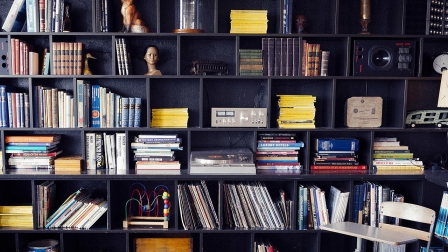What Happened When I Got Rid Of Everything In My House That Doesn’t Spark Joy
I hate clutter. Growing up, my favorite book (and the only one I kept from my childhood) was The Boxcar Children, a story of four orphans who live in an abandoned train car with few belongings. I didn’t realize it until I became an adult, but this book resonated with me because I’ve always had minimalist tendencies. Less is definitely more.
Then stuff happens: Marriage, kids, pets, and, while it’s hard to admit, keeping up with the Joneses. Suddenly, our closets, cabinets, and drawers were bursting with things we never knew we needed.
One of my favorite things to do when I’m bored is de-clutter—it makes me happy to see open spaces and order—so when The Life-Changing Magic of Tidying Up by Japanese cleaning guru Marie Kondo came out in 2014, I eagerly grabbed a copy.
The Process
Kondo’s process, called the “KonMari Method,” has six rules of tidying:
- Commit yourself to tidying up. Know that it will take time and be willing to stick to it.
- Imagine your ideal lifestyle, including the kind of house you want to live in and how you want to live in it. You can write down this description or collect photos.
- Finish discarding first. Instead of running out to the Container Store and buying storage bins, plan where to store your items once you’ve decided what to keep.
- Tidy by category, not location. Gathering all like items in the house, such as books or shoes, helps you make better decisions because you know what you have.
- Follow the right order. Kondo has a category-sorting plan that you must follow, because it helps you gradually hone your ability to identify what sparks joy.
- Ask yourself if it sparks joy. Hold every one of your possessions in your hands and ask, “Does this spark joy?” If it does, you keep it.
Tuning into your joy meter can take time and practice. Do socks really spark joy? They indeed do when you consider their job of protecting your feet. If an item doesn’t spark joy, you thank it for its service and dispose of it. I admit this is kind of out there, especially for items like paper clips, but I went with it.
Getting Started
The first category is clothing, which was easy for me because I’m not into fashion. Still, I surprised myself by the number of things I was able to remove from my wardrobe. I brought two dozen items to the consignment store and donated five full bags to Salvation Army. I was able to reconfigure my closet and create space to hang a piece of artwork that has been in my basement for years just waiting for the right spot.
The next category—books—was surprisingly easy, too. I envisioned the words being trapped in shelves inside my house. These went to my library’s used book sale, and releasing them out into the world so others could enjoy them felt powerful.
Then came papers. I was stuck—for almost a year. Papers felt daunting to me because Kondo recommends getting rid of almost all of them. I had no problem sending tax returns from the ‘90s to the shredder and instruction manuals to the recycling bin, but other documents, like interview notes and my children’s report cards, caused an internal dilemma that paralyzed my progress.
During my tidying hiatus, Kondo’s second book, Spark Joy: An Illustrated Master Class on the Art of Organizing and Tidying Up, came out. In it she writes, “If it makes you happy, then the right choice is to keep it confidently, regardless of what anyone else says.” This validated my decision to keep papers Kondo suggests are unnecessary. Instead of two filing cabinets and three overflowing boxes, I now have one filing cabinet. And when my son’s ear buds stopped working, I quickly found the receipt and filed a warranty claim.
The largest category Kondo calls “komono,” a Japanese term for knick-knacks, small accessories and various odds and ends. It covers a wide range of stuff, from office supplies to kitchen items to all of those electronic cords you keep for no good reason. I went through everything one by one. Tedious is an understatement, and according to Kondo’s rules, you can’t do the process while watching television or even listening to music. You must give it your full attention.
“Anxiety arises from not being able to see the whole picture,” writes Kondo. This is where having a vision for your home helps. It’s like keeping your eyes on the prize. It also helps to join KonMari Facebook groups for support; going through the process with others is encouraging.
The final, and toughest, category is sentimental items. We have numerous boxes of photos, and I went through the piles and eliminated doubles and blurry pictures. Then our dog died on the weekend that I had saved to finish this category. While it’s not complete, I felt reassured when I read in Spark Joy that Kondo only recently finished sorting her own photos.
When You’re Done
Kondo writes in her book that her clients reach a click point, a realization that you have just the right amount of stuff. “It’s the moment when, after discarding everything but the things you love, you know that you have all you need to feel content,” Kondo writes.
This is true. During the process, we rearranged our furniture and got rid of pieces that just took up space. We also donated dozens of boxes and bags filled with household items. It felt like pruning a garden so that the treasured items could shine, and it led to a deep sense of calm. When a neighbor stopped by unexpectedly to drop off something for my son, for example, I invited her in without worrying about what might be piled up on my kitchen counter.
While Kondo doesn’t mention this in her book, there’s science behind the anxiety you feel when you’re surrounded by clutter. A study from UCLA found that your cortisol level spikes when your home is overloaded with stuff. Just like multitasking overloads your brain, clutter overloads your senses, causing you to be stressed out. Another study, this one from the Princeton University Neuroscience Institute, found that “multiple stimuli present in the visual field”—aka. clutter—limits your ability to process information and increases the chances you’ll become distracted.
“To put your house in order is to put your life in order,” writes Kondo. A common side effect of this process is the ability to make decisions about relationships, activities, or careers. In fact, several people on the KonMari Facebook groups say that they’ve ended bad relationships or quit unfulfilling jobs. For me, I stopped taking freelance work that didn’t bring me joy. And the frequent anxiety attacks I’d get about having too much to do (and not enough time to do it) went away.
Michelle Sischo of Chapel Hill, N.C., a member of the Konmari Adventures Facebook group, went through the process when she moved into a smaller home. She discovered she had more time to spend with her 4-year-old son, and she’s decided to fulfill a goal and write a book about her personal experience with adoption.
“KonMari helps you clear your mind and focus on what’s important,” she says. “Before I would always feel flustered if didn’t have a neat desk. I couldn’t work. And with email, texts, and phone calls, you’re expected to multitask all day. KonMari allows you to figure out what’s important, decide what you want to do, and have time to do those things.”
The KonMari Method is a marathon, and at times you might feel like you want to quit. But, just like running the distance, wait for the second wind. The constant feeling of contentment is worth the journey.
Fast Company , Read Full Story
(39)













